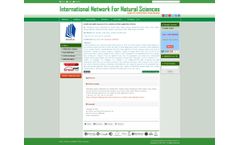Durum Wheat Articles & Analysis
10 articles found
Effects of boron fertilization on the yield and some yield components of bread and durum wheat. Turkish Journal of Agriculture and Forestry 27, 329-335. ...
Based on the Common Agricultural Policy (CAP), a replacement of 30% of the actual tomato areas in Foggia Province with sunflowers (energy crop) or durum wheat (rainfed crop) has potential water saving of 9 million m3 and 67 million m3, respectively. ...
(DIC hereafter) chromosome 6BS revealed that modern wheat varieties have a nonfunctional allele. The DIC allele accelerates senescence and increases grain protein concentration (GPC) relative to the nonfunctional allele, but its effect on yield is not known. Here we describe the effect of Gpc-B1 on grain yield, grain weight, protein yield (grain yield by GPC), and N harvest index ...
Phytoene synthase (PSY) genes are involved in the biosynthesis of carotenoid pigments in durum wheat [Triticum turgidum L. subsp. durum (Desf.) Husn.], significantly influencing grain yellowness. This study was conducted to identify new allelic variants at the Psy-A1 and Psy-B1 loci in durum wheat, and to ...
Henn.), a devastating disease of wheat (Triticum aestivum L.), was effectively controlled worldwide for the past 50 yr by deployment of stem rust resistance (Sr) genes in wheat cultivars. ...
They also help elucidate the genetic control of chromosome pairing inherently present in allopolyploids such as bread wheat, durum wheat, and oats. Genetic control of chromosome pairing in haploid nuclei has helped in assessing intergenomic relationships. By analyzing the degree and specificity of chromosome pairing in the Ph1- and ...
Little is known about the slow-rusting type of resistance to leaf rust in durum wheat [Triticum turgidum L. ssp. durum (Desf.) Husn.]. The genetic basis of slow-rusting resistance was investigated in eight International Maize and Wheat Improvement Center (CIMMYT)–derived durum wheat lines. ...
This study focused on the effect of plant height on weed competitiveness of a set of near-isogenic wheat lines (NILs). The set included seven bread wheat (Triticum aestivium L.) and six durum wheat (T. turgidum L.) cultivars, each having a semidwarf and tall near-isogenic line. ...
This work assesses the changes resulting from durum wheat (Triticum turgidum L. var. durum) breeding in Italy and Spain during the 20th century on grain filling, biomass production, and allocation at anthesis, and the remobilization of preanthesis photosynthates to the grain of main stems. ...
The objective of this study was to determine the yield responses of spring wheat (Triticum aestivum L.) and durum [T. turgidum subsp. durum (Desf.) Husn.] to Cu fertilization, and to determine whether wheat leaf rust (Puccinia triticina Roberge ex Desmaz f. sp. tritica), tan spot [Pyrenophora tritica-repentis (Died.) ...



